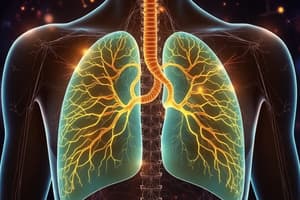Podcast
Questions and Answers
Which enzyme is responsible for the degradation of dopamine in the synaptic cleft?
Which enzyme is responsible for the degradation of dopamine in the synaptic cleft?
- COMT
- UPS
- MAO (correct)
- AD
Which of the following diseases is associated with insufficient dopamine in the nigrostriatal pathway?
Which of the following diseases is associated with insufficient dopamine in the nigrostriatal pathway?
- Tourette syndrome
- Attention deficit hyperactivity disorder
- Parkinson's disease (correct)
- Schizophrenia
What is the main neurotransmitter involved in motor control?
What is the main neurotransmitter involved in motor control?
- Acetylcholine
- Dopamine (correct)
- GABA
- Serotonin
What is the role of the substantia nigra in motor control?
What is the role of the substantia nigra in motor control?
What is the main cause of the loss of pigmentation in the substantia nigra in Parkinson's disease?
What is the main cause of the loss of pigmentation in the substantia nigra in Parkinson's disease?
Which of the following is a common treatment for Parkinson's disease that enhances dopamine signaling?
Which of the following is a common treatment for Parkinson's disease that enhances dopamine signaling?
What was covered in Lecture 1?
What was covered in Lecture 1?
What is the role of COMT in dopamine degradation?
What is the role of COMT in dopamine degradation?
What are Lewy bodies?
What are Lewy bodies?
What are the sites of action of common treatments for Parkinson's disease?
What are the sites of action of common treatments for Parkinson's disease?
Which of the following is true about biogenic amines?
Which of the following is true about biogenic amines?
What is the role of tyrosine hydroxylase?
What is the role of tyrosine hydroxylase?
Which transporter is responsible for the uptake and storage of catecholamines and indoleamines?
Which transporter is responsible for the uptake and storage of catecholamines and indoleamines?
What is the role of reserpine in neurotransmission?
What is the role of reserpine in neurotransmission?
Which receptors are coupled to G proteins in dopamine neurotransmission?
Which receptors are coupled to G proteins in dopamine neurotransmission?
What is the effect of D1-like receptors on adenylate cyclase activity?
What is the effect of D1-like receptors on adenylate cyclase activity?
Where are vesicles containing dopamine β-hydroxylase (DBH) found?
Where are vesicles containing dopamine β-hydroxylase (DBH) found?
Which of the following is NOT true about tyrosine?
Which of the following is NOT true about tyrosine?
What is the role of catecholamines in the body?
What is the role of catecholamines in the body?
What is the diagnostic marker for catecholaminergic cells?
What is the diagnostic marker for catecholaminergic cells?
Study Notes
Dopamine and Motor Control
- The enzyme COMT is responsible for the degradation of dopamine in the synaptic cleft.
- Insufficient dopamine in the nigrostriatal pathway is associated with Parkinson's disease.
Neurotransmitters and Enzymes
- Dopamine is the main neurotransmitter involved in motor control.
- Tyrosine hydroxylase is the enzyme responsible for converting tyrosine into L-DOPA, a precursor to dopamine.
Substantia Nigra and Parkinson's Disease
- The substantia nigra is involved in motor control and is affected in Parkinson's disease.
- The loss of pigmentation in the substantia nigra in Parkinson's disease is due to the death of dopaminergic neurons.
Treatments for Parkinson's Disease
- Dopamine Enhancers, such as L-DOPA, are a common treatment for Parkinson's disease that enhance dopamine signaling.
- Reserpine, a drug that depletes catecholamine stores, has an opposite effect on dopamine signaling.
Biogenic Amines and Neurotransmission
- Biogenic amines, including dopamine, norepinephrine, and serotonin, are synthesized from amino acids.
- Vesicles containing dopamine β-hydroxylase (DBH) are found in postganglionic neurons of the sympathetic nervous system.
- The VMAT (vesicular monoamine transporter) is responsible for the uptake and storage of catecholamines and indoleamines.
- D1-like receptors are coupled to G proteins and increase adenylate cyclase activity when stimulated.
Catecholamines and Lewy Bodies
- Catecholamines, including dopamine, norepinephrine, and epinephrine, are involved in various bodily functions, such as motor control and stress response.
- Lewy bodies are abnormal protein clumps found in catecholaminergic cells and are a hallmark of Parkinson's disease.
- Tyrosine is not converted into L-DOPA by tyrosine hydroxylase in the absence of a cofactor.
Diagnostic Markers
- The presence of TH-positive neurons is a diagnostic marker for catecholaminergic cells.
Studying That Suits You
Use AI to generate personalized quizzes and flashcards to suit your learning preferences.
Related Documents
Description
Test your knowledge on biogenic amines, bioactive amine neurotransmitters implicated in various behaviors such as movement, reward, addiction, depression, and sleep. Learn about the catecholamines and their role as neurotransmitters like dopamine and norepinephrine. Explore the pharmacological drugs that affect their neurotransmission.



